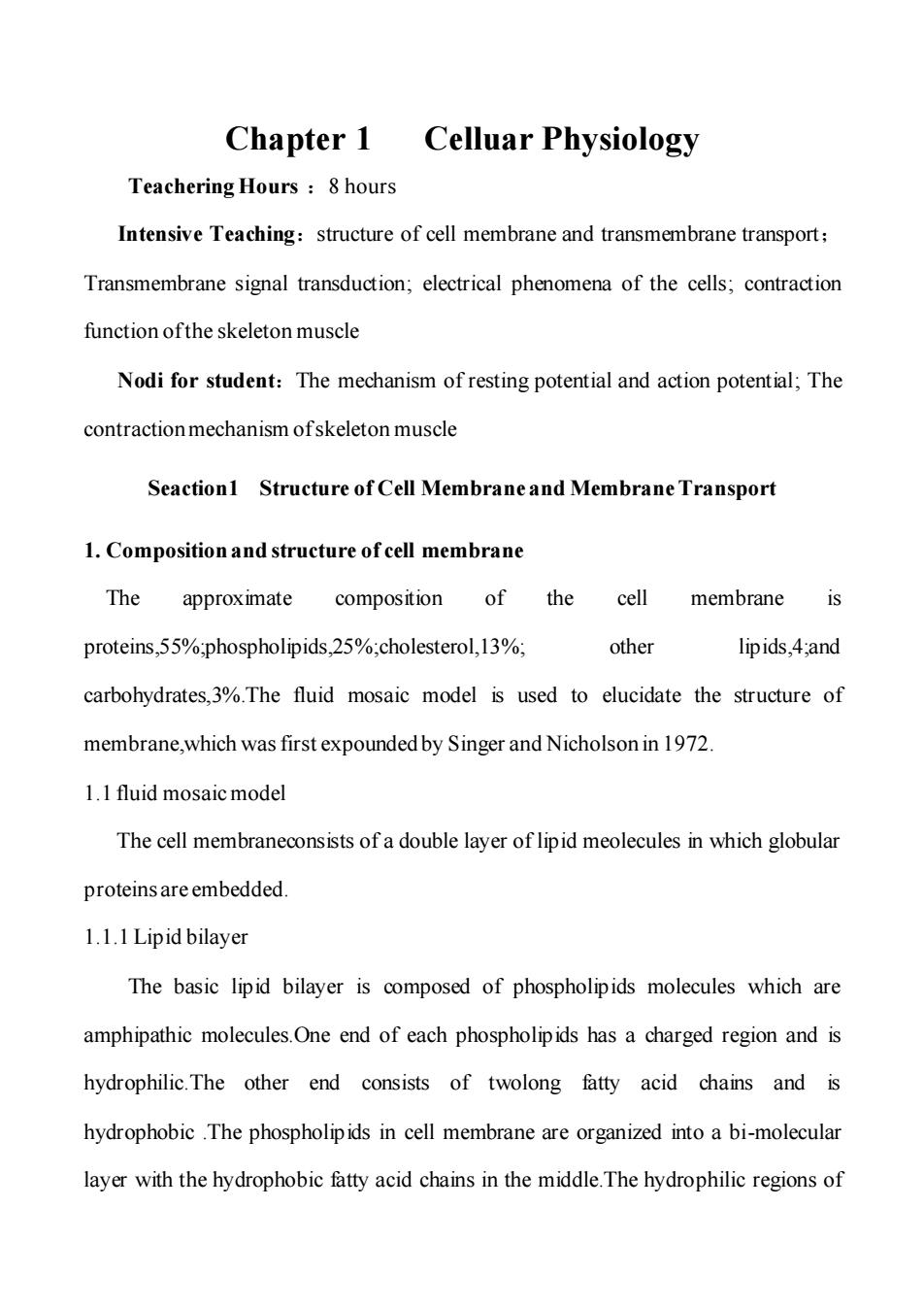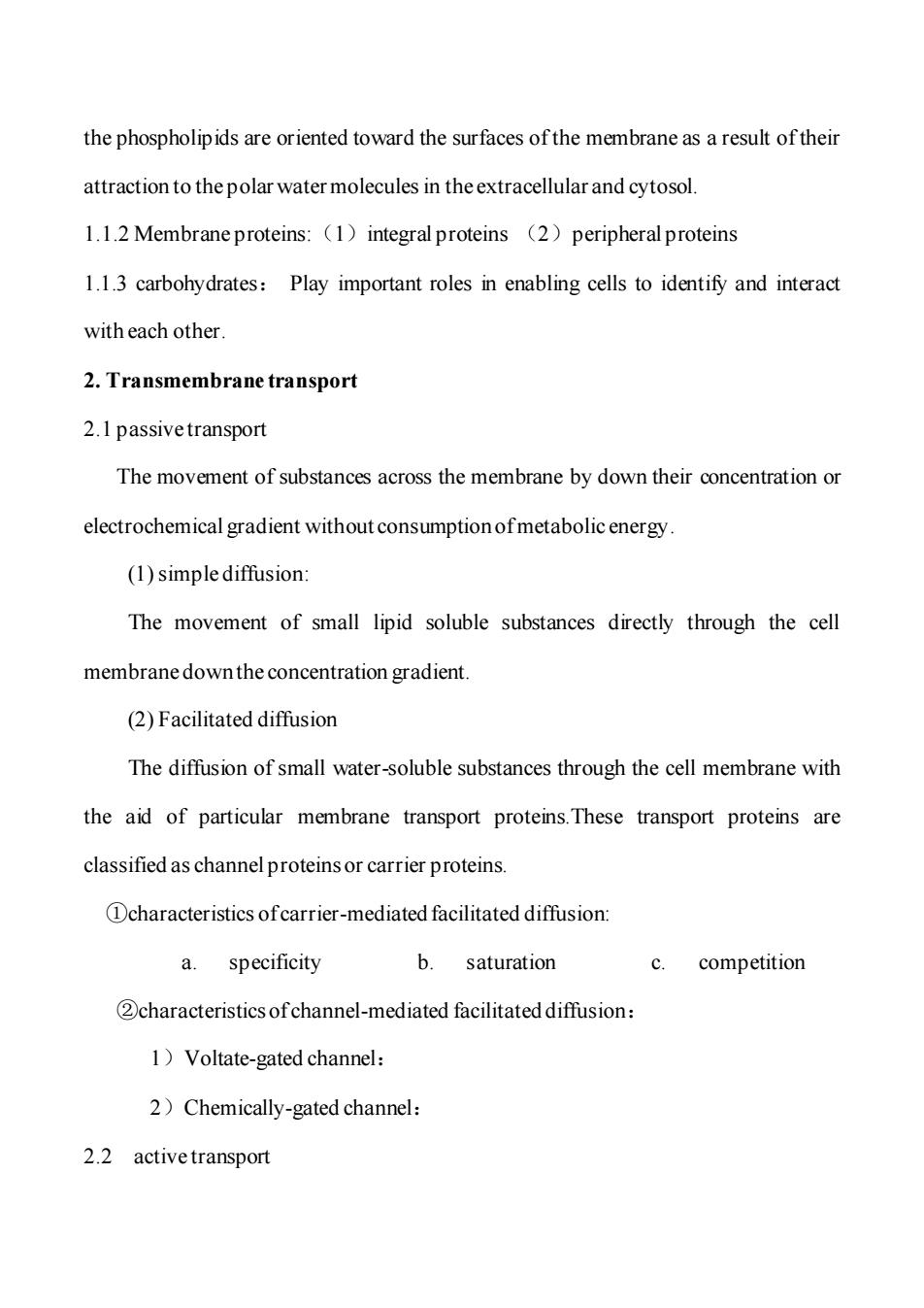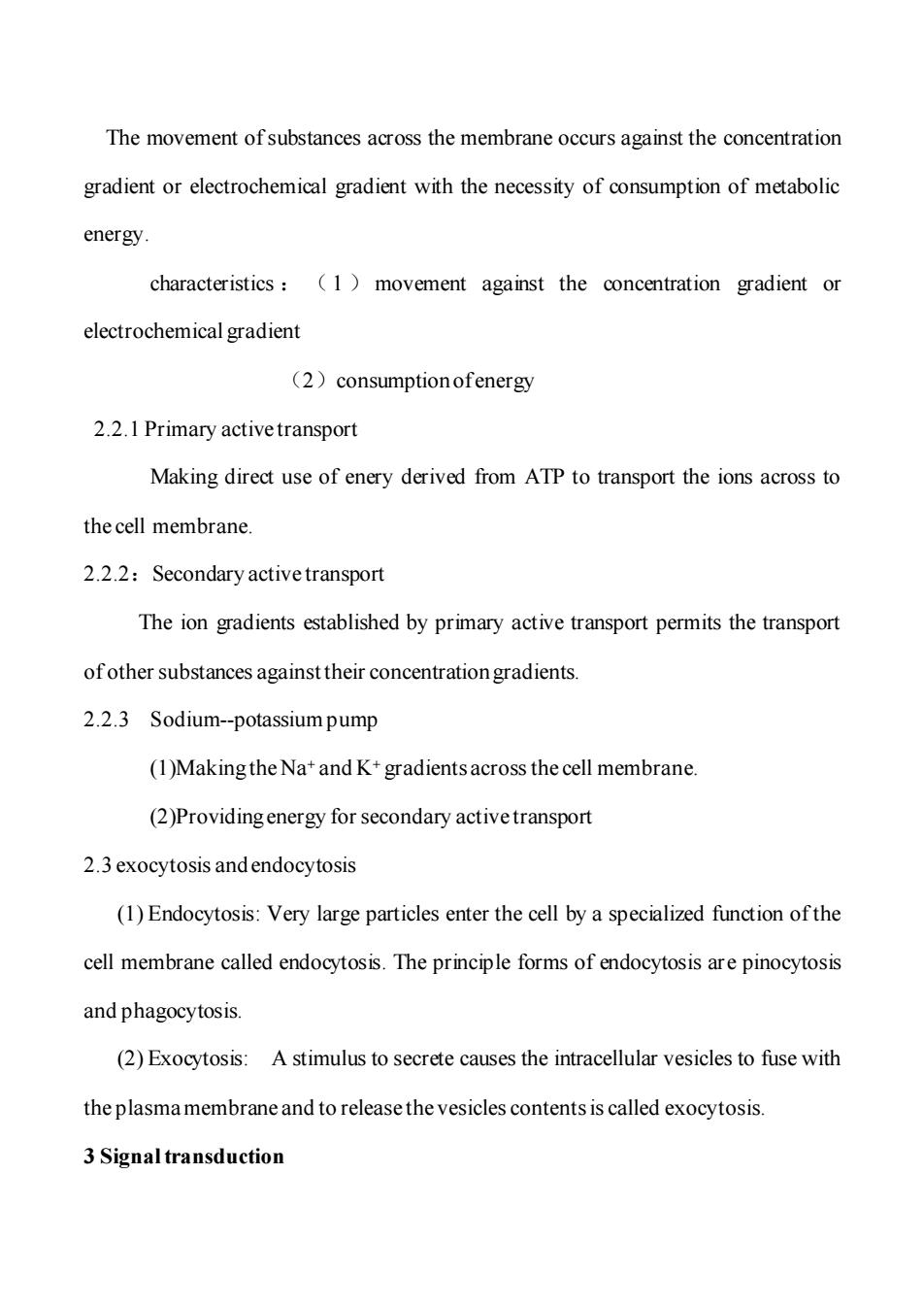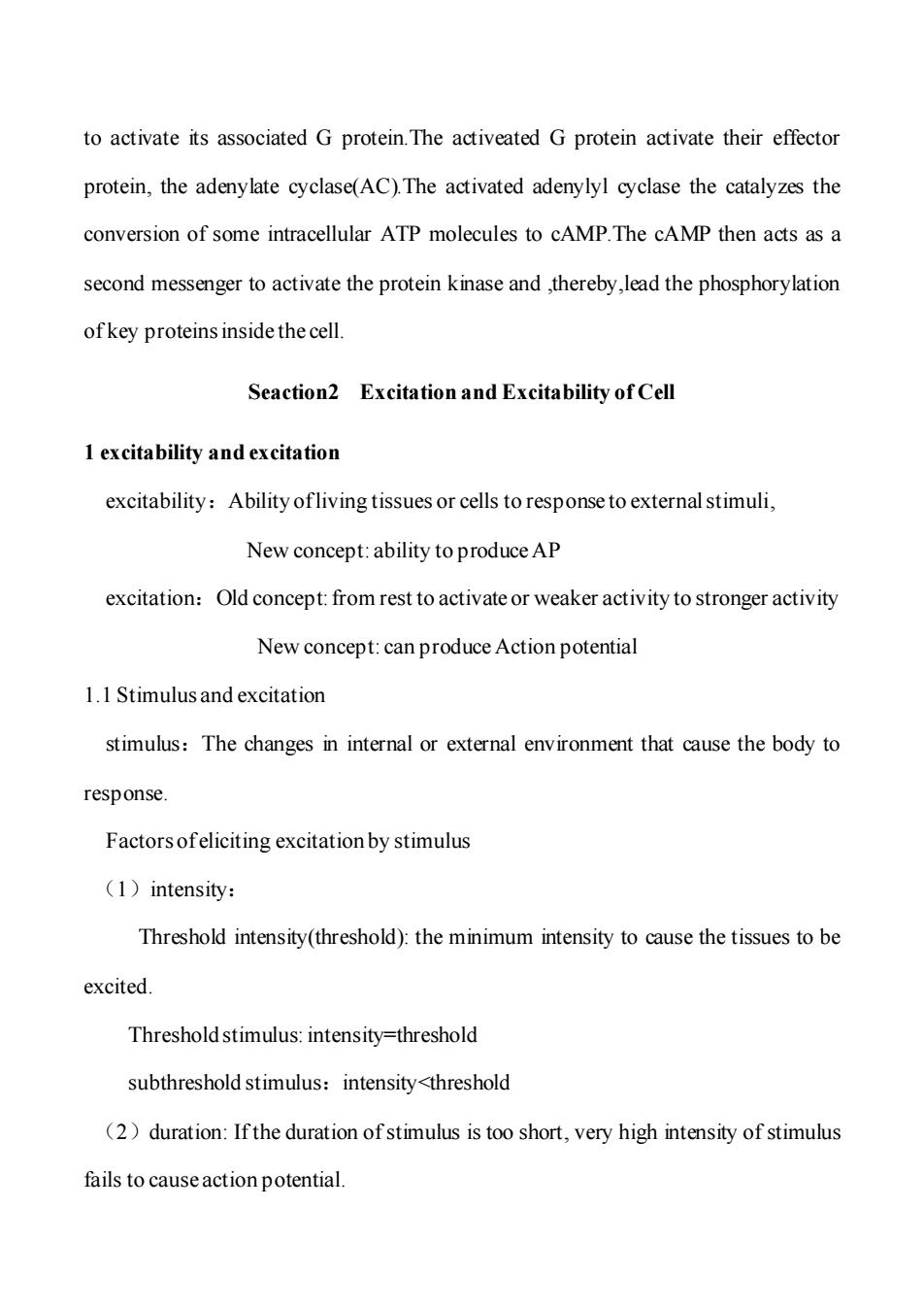
Chapter 1 Celluar Physiology Teachering Hours 8 hours Intensive Teaching:structure of cell membrane and transmembrane transport; Transmembrane signal transduction;electrical phenomena of the cells;contraction function ofthe skeleton muscle Nodi for student:The mechanism of resting potential and action potential;The contraction mechanism ofskeleton muscle Seaction1 Structure of Cell Membrane and Membrane Transport 1.Composition and structure of cell membrane The approximate composition of the cell membrane proteins,55%;phospholipids,25%;cholesterol,13%: other lipids,4;and carbohydrates.3%.The fluid mosaic model is used to elucidate the structure of membrane,which was first expounded by Singer and Nicholson in 1972. 1.1 fluid mosaic model The cell membraneconsists of a double layer of lipid meolecules in which globular proteins are embedded. 1.1.1 Lipid bilayer The basic lipid bilayer is composed of phospholipids molecules which are amphipathic molecules.One end of each phospholipids has a charged region and is hydrophilic.The other end consists of twolong fatty acid chains and is hydrophobic.The phospholipids in cell membrane are organized into a bi-molecular layer with the hydrophobic fatty acid chains in the middle.The hydrophilic regions of
Chapter 1 Celluar Physiology Teachering Hours :8 hours Intensive Teaching:structure of cell membrane and transmembrane transport; Transmembrane signal transduction; electrical phenomena of the cells; contraction function of the skeleton muscle Nodi for student:The mechanism of resting potential and action potential; The contraction mechanism of skeleton muscle Seaction1 Structure of Cell Membrane and Membrane Transport 1. Composition and structure of cell membrane The approximate composition of the cell membrane is proteins,55%;phospholipids,25%;cholesterol,13%; other lipids,4;and carbohydrates,3%.The fluid mosaic model is used to elucidate the structure of membrane,which was first expounded by Singer and Nicholson in 1972. 1.1 fluid mosaic model The cell membraneconsists of a double layer of lipid meolecules in which globular proteins are embedded. 1.1.1 Lipid bilayer The basic lipid bilayer is composed of phospholipids molecules which are amphipathic molecules.One end of each phospholipids has a charged region and is hydrophilic.The other end consists of twolong fatty acid chains and is hydrophobic .The phospholipids in cell membrane are organized into a bi-molecular layer with the hydrophobic fatty acid chains in the middle.The hydrophilic regions of

the phospholipids are oriented toward the surfaces of the membrane as a result of their attraction to the polar water molecules in the extracellular and cytosol. 1.1.2 Membrane proteins:(1)integral proteins (2)peripheral proteins 1.1.3 carbohydrates:Play important roles in enabling cells to identify and interact with each other. 2.Transmembrane transport 2.1 passivetransport The movement of substances across the membrane by down their concentration or electrochemical gradient without consumption of metabolic energy. (1)simple diffusion: The movement of small lipid soluble substances directly through the cell membrane down the concentration gradient. (2)Facilitated diffusion The diffusion of small water-soluble substances through the cell membrane with the aid of particular membrane transport proteins.These transport proteins are classified as channel proteins or carrier proteins. 1characteristics ofcarrier-mediated facilitated diffusion: a.specificity b.saturation competition 2characteristics of channel-mediated facilitated diffusion: 1)Voltate-gated channel: 2)Chemically-gated channel: 2.2 activetransport
the phospholipids are oriented toward the surfaces of the membrane as a result of their attraction to the polar water molecules in the extracellular and cytosol. 1.1.2 Membrane proteins:(1)integral proteins (2)peripheral proteins 1.1.3 carbohydrates: Play important roles in enabling cells to identify and interact with each other. 2. Transmembrane transport 2.1 passive transport The movement of substances across the membrane by down their concentration or electrochemical gradient without consumption of metabolic energy. (1) simple diffusion: The movement of small lipid soluble substances directly through the cell membrane down the concentration gradient. (2) Facilitated diffusion The diffusion of small water-soluble substances through the cell membrane with the aid of particular membrane transport proteins.These transport proteins are classified as channel proteins or carrier proteins. ①characteristics of carrier-mediated facilitated diffusion: a. specificity b. saturation c. competition ②characteristics of channel-mediated facilitated diffusion: 1)Voltate-gated channel: 2)Chemically-gated channel: 2.2 active transport

The movement of substances across the membrane occurs against the concentration gradient or electrochemical gradient with the necessity of consumption of metabolic energy characteristics (1 movement against the concentration gradient or electrochemical gradient (2)consumption ofenergy 2.2.1 Primary activetransport Making direct use of enery derived from ATP to transport the ions across to the cell membrane. 2.2.2:Secondary active transport The ion gradients established by primary active transport permits the transport of other substances against their concentration gradients. 2.2.3 Sodium--potassium pump (1Making the Na+and K+gradients across the cell membrane. (2)Providing energy for secondary activetransport 2.3 exocytosis and endocytosis (1)Endocytosis:Very large particles enter the cell by a specialized function of the cell membrane called endocytosis.The principle forms of endocytosis are pinocytosis and phagocytosis. (2)Exocytosis:A stimulus to secrete causes the intracellular vesicles to fuse with the plasma membrane and to release the vesicles contents is called exocytosis. 3 Signal transduction
The movement of substances across the membrane occurs against the concentration gradient or electrochemical gradient with the necessity of consumption of metabolic energy. characteristics : (1 ) movement against the concentration gradient or electrochemical gradient (2)consumption of energy 2.2.1 Primary active transport Making direct use of enery derived from ATP to transport the ions across to the cell membrane. 2.2.2:Secondary active transport The ion gradients established by primary active transport permits the transport of other substances against their concentration gradients. 2.2.3 Sodium--potassium pump (1)Making the Na+ and K+ gradients across the cell membrane. (2)Providing energy for secondary active transport 2.3 exocytosis and endocytosis (1) Endocytosis: Very large particles enter the cell by a specialized function of the cell membrane called endocytosis. The principle forms of endocytosis are pinocytosis and phagocytosis. (2) Exocytosis: A stimulus to secrete causes the intracellular vesicles to fuse with the plasma membrane and to release the vesicles contents is called exocytosis. 3 Signal transduction

Signal transduction refers to the processes by which intercellular messengers (such as neurotransmitters,hormones and cytokines)which bind to specific receptors on or in the target cell,are converted into biochemical and/or electrical signals within that cell.In turn,such signals can modify cellular function in different ways.Three general patterns of signal transduction occur in almost all mammalian cells.One is signal transduction mediated by G-protein coupled receptor.G-protein serve as intermediaries between receptor and the enzymes or ion channels that activated by agonist binding.The second is signal transduction mediated by ion channel-coupled receptors which help regulate the intracellular concentration of specific ions.The third pattern,some membrane receptors are protein kinases called tyrosine protein kinase that are activated directly by agonist binding. Several basic concepts for the signal transduction first messenger:including the lipid-insoluble messenger and lipid-soluble messenger. Second messenger:it is the signal molecule that produced in interior of cell and can transfer the informations carried by first messenger to regulate the protein kinases and ion channels,and to initiate the physiological and biochemical reactions.For example: cAMP,cGMP,IP3,DG,Ca2+etc. protein kinase:It can phosphorylate specific proteins,triggering biochemical reaction that lead to the cell's response to the hormone Signal transduction mediated by G-protein-linked receptor pathway Activation of the receptor by the binding ofthe first messenter allows the receptor
Signal transduction refers to the processes by which intercellular messengers (such as neurotransmitters, hormones and cytokines) which bind to specific receptors on or in the target cell, are converted into biochemical and/or electrical signals within that cell. In turn, such signals can modify cellular function in different ways. Three general patterns of signal transduction occur in almost all mammalian cells. One is signal transduction mediated by G-protein coupled receptor. G-protein serve as intermediaries between receptor and the enzymes or ion channels that activated by agonist binding. The second is signal transduction mediated by ion channel-coupled receptors which help regulate the intracellular concentration of specific ions. The third pattern, some membrane receptors are protein kinases called tyrosine protein kinase that are activated directly by agonist binding. Several basic concepts for the signal transduction first messenger: including the lipid-insoluble messenger and lipid-soluble messenger. Second messenger: it is the signal molecule that produced in interior of cell and can transfer the informations carried by first messenger to regulate the protein kinases and ion channels, and to initiate the physiological and biochemical reactions. For example: cAMP, cGMP, IP3, DG, Ca2+ etc. protein kinase: It can phosphorylate specific proteins, triggering biochemical reaction that lead to the cell’s response to the hormone Signal transduction mediated by G-protein-linked receptor pathway Activation of the receptor by the binding of the first messenter allows the receptor

to activate its associated G protein.The activeated G protein activate their effector protein,the adenylate cyclase(AC).The activated adenylyl cyclase the catalyzes the conversion of some intracellular ATP molecules to cAMP.The cAMP then acts as a second messenger to activate the protein kinase and ,thereby,lead the phosphorylation ofkey proteins inside the cell. Seaction2 Excitation and Excitability of Cell 1 excitability and excitation excitability:Ability ofliving tissues or cells to response to external stimuli, New concept:ability to produce AP excitation:Old concept:from rest to activate or weaker activity to stronger activity New concept:can produce Action potential 1.1 Stimulus and excitation stimulus:The changes in internal or external environment that cause the body to response. Factors ofeliciting excitation by stimulus (1)intensity: Threshold intensity(threshold):the minimum intensity to cause the tissues to be excited. Threshold stimulus:intensity=threshold subthreshold stimulus:intensity<threshold (2)duration:If the duration of stimulus is too short,very high intensity of stimulus fails to cause action potential
to activate its associated G protein.The activeated G protein activate their effector protein, the adenylate cyclase(AC).The activated adenylyl cyclase the catalyzes the conversion of some intracellular ATP molecules to cAMP.The cAMP then acts as a second messenger to activate the protein kinase and ,thereby,lead the phosphorylation of key proteins inside the cell. Seaction2 Excitation and Excitability of Cell 1 excitability and excitation excitability:Ability of living tissues or cells to response to external stimuli, New concept: ability to produce AP excitation:Old concept: from rest to activate or weaker activity to stronger activity New concept: can produce Action potential 1.1 Stimulus and excitation stimulus:The changes in internal or external environment that cause the body to response. Factors of eliciting excitation by stimulus (1)intensity: Threshold intensity(threshold): the minimum intensity to cause the tissues to be excited. Threshold stimulus: intensity=threshold subthreshold stimulus:intensity<threshold (2)duration: If the duration of stimulus is too short, very high intensity of stimulus fails to cause action potential